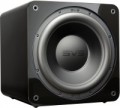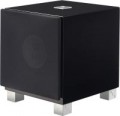Acoustic design
—
Closed type. The simplest type of construction: a closed (sometimes hermetically sealed) case with a speaker placed on the front panel. It is believed that such subwoofers have low sensitivity, which, however, is offset by high sound transmission accuracy and low distortion.
—
Phase inverter type. In the cases of such subwoofers, a tube is installed that has an outlet to the surrounding space. The length of the tube is chosen so that a signal comes out of it, inverted in phase relative to the signal from the front of the cone (in other words, from the main speaker). This improves the sound of the subwoofer and enhances the sound pressure. The disadvantage of a phase inverter is the additional noise from the sound stream in the tube.
—
With a passive radiator. A design similar to a phase inverter (see above) in terms of purpose and principle of operation, however, instead of a tube, such subwoofers use the so-called passive emitter. In fact, it is an ordinary speaker, devoid of a coil and a magnet and playing the same role as the phase inverter tube. The use of a passive radiator allows you to get rid of the noise of the air flow, characteristic of phase inverters.
Features
—
Home. General purpose subwoofers not covered by any other specialty (see below). The name “home” quite accurately describes their main purpose, but, of course, the matter is not limited to home acoustic systems: such “subs” can be used in cafes and bars, on skating rinks and rollerdromes and other public places.
—
Concert. Subwoofers designed for use at concerts and other mass events are distinguished primarily by high power — hundreds or even thousands of watts. This allows you to cover large areas with powerful rich sound.
—
Studio. Subwoofers designed for professional audio applications, primarily in recording studios. They are also called "monitors" (however, this is the common name for all studio speakers). Differ in extremely high fidelity of a sound transmission.
—
Landscape. Models designed for outdoor installation — for example, in the courtyard of a private house, on the territory of an entertainment complex, etc. The most noticeable difference between such models and classic home ones is their appearance: landscape subwoofers must fit into the design of the area, so they are often “disguised” as a stone, flower pot, ground lamp, etc. In addition, the cases of such speakers are well protected from moisture, dust and other adverse factors associated with being outdoors. And the placement method m
...ay involve not only simple installation on the ground, but also digging into the ground, depending on the model.
Note that the use of a subwoofer for other than its “native” purpose is technically possible, however, usually, it is not justified: a concert model in the house will be redundant, an ordinary home “sub” can be put outside only until the first rain, etc.Power
Rated power of the subwoofer. Technically, this is the highest average (rms) sound power at which the device can work normally (without sound distortion and damage to components) for an unlimited time. Simply put, the more powerful the subwoofer, the louder it is. The choice for this parameter depends primarily on the size of the space / room that is planned to be covered; detailed recommendations for different situations can be found in special sources.
Also, the power is directly related to the characteristics of the amplifier used with the subwoofer. For active subwoofers (see "Type"), this item actually indicates the nominal power of the built-in amplifier; the speaker itself can be more powerful, but it doesn't matter anymore. For passive models, the power rating corresponds to the highest amplifier power that can be connected to the speaker without the risk of damaging it at high volume.
Max. sound pressure level
The highest sound pressure level that a subwoofer can create, in other words, the volume that it produces at its maximum power level. This parameter is measured in the same way as any noise level - in decibels; since the decibel is a non-linear quantity, it is easiest to evaluate loudness using comparative tables. So, the most modest modern subwoofers are capable of delivering up to 95 – 100 dB, this is comparable to the volume of a subway car or a chainsaw. In the most powerful ones, it can exceed 130 dB - this is louder than an airplane on takeoff, a long stay near a subwoofer operating at full power can lead to hearing damage.
Note that sound pressure and sensitivity (see above) are fundamentally different characteristics, although they are measured by the same units.
Frequency range
The range of audio frequencies reproduced by the subwoofer. As a general rule, the wider the frequency range, the richer the sound and the more detail the speaker can convey. However, it is worth remembering that subwoofers as a class are designed for low and ultra-low frequencies in the range from 20 to 150 (sometimes 200) Hz. Therefore, in fact, a significant difference in sound is noticeable only with a large difference in the reproducible ranges (for example, 20-200 Hz and 50-150 Hz).
Also, do not forget that an extensive frequency range is not yet a guarantee of high-quality sound; and in some cases (for example, if the main speakers of the speaker also cope well with low frequencies), it may be completely redundant.
Speaker size
The diameter of the speaker(s) installed in the subwoofer.
It is believed that the larger the speaker (
15 ",
18 " and more), the more power it can produce and the deeper the bass will be on such acoustics. However, in modern subwoofers, manufacturers use various tricks that allow achieving good sound depth even with relatively small speaker sizes (
10 ",
8 "). Therefore, it is possible to compare different models only if they differ significantly in this indicator; and even then, in such cases, it is worth paying attention not so much to the speaker diameter as to the price category. The golden mean among sizes is
12-inch subwoofers.
Wireless connection
The presence of a
wireless connection in a subwoofer is most often Bluetooth: this standard is practically generally accepted in modern electronics, it is supported by the vast majority of smartphones, tablets and laptops. Note that we can talk about connecting an audio signal, as well as connecting to a device like a smartphone or tablet to manage settings. However, the latter option is not common — mainly in concert models, based on the ability to reconfigure the subwoofer even in a situation where there is no direct access to it.
If we talk about wireless sound transmission, then this option is convenient primarily from the point of view of choosing the optimal installation location: moving the subwoofer around the room, you do not need to mess with wires, and the Bluetooth range reaches 10 m. However, the quality of sound transmission with a wireless connection may be lower than with wired, but for bass this point is not as noticeable as for other frequency bands.
Adjustable crossover
The presence of an
adjustable crossover in the design of the subwoofer.
A crossover is a device that divides the audio signal into separate frequency bands and directs each band to "its own" speakers. See "Crossover Frequency" for more on this. Here we note that the adjustable crossover allows you to change the upper threshold of the frequencies supplied to the subwoofer. This allows you to optimally match the bass speaker with the main speakers — so that, on the one hand, the bass does not overlap, on the other, there is no gap between the subwoofer and the rest of the acoustics.
Crossover frequency
Cutoff frequency of the crossover installed in the subwoofer (or supplied with it — for passive models, see "Type").
The crossover splits the audio signal into separate frequencies so that only the bass goes to the subwoofer and only the main range goes to the speakers. Such a device is mainly equipped with home models (see above). And the crossover frequency is the upper threshold of the frequencies fed to the subwoofer. This information is important for matching with the rest of the speakers: ideally, the lower threshold of the main acoustics should correspond to the upper threshold of the subwoofer, otherwise the frequencies will either overlap or dip in them (neither of which contributes to sound quality). For the convenience of matching, the crossover can be made adjustable (see above).

